What Is Freelancing and How Does It Work? (Complete Guide with Pros and Cons)
Trust Score: 4.8
356 reviews

Table of Contents
You’ve probably seen the word “freelance” everywhere — from LinkedIn job posts to Instagram stories, from tweets about “side hustles” to TikToks showing a day in the life of a freelancer. And for good reason: freelancing isn’t just a passing trend — it’s rapidly becoming a mainstay of how people work globally.
Here are some eye-opening numbers:
 As of 2025, there are approximately 1.57 billion freelancers worldwide, making up about 46.6–46.7% of the global workforce. Jobbers+2DemandSage+2
As of 2025, there are approximately 1.57 billion freelancers worldwide, making up about 46.6–46.7% of the global workforce. Jobbers+2DemandSage+2 In the United States alone, there are ~ 76.4 million freelancers in 2024, expected to increase further by 2027. Market.biz+2Sci-Tech Today+2
In the United States alone, there are ~ 76.4 million freelancers in 2024, expected to increase further by 2027. Market.biz+2Sci-Tech Today+2 LinkedIn’s Services Marketplace recently reported that 10 million people have signed up as freelancers on that marketplace — up ~48% year-over-year. TechCrunch
LinkedIn’s Services Marketplace recently reported that 10 million people have signed up as freelancers on that marketplace — up ~48% year-over-year. TechCrunch According to a LinkedIn news report (May 2025), demand for consultants and project-based talent surged 38% in FY25 (up from ~17% two years ago), particularly in tech, FMCG, health care, financial services. LinkedIn
According to a LinkedIn news report (May 2025), demand for consultants and project-based talent surged 38% in FY25 (up from ~17% two years ago), particularly in tech, FMCG, health care, financial services. LinkedIn
These trends tell us something important:
 Freelance work is shifting from being something people do on the side, to something many see as a primary source of income.
Freelance work is shifting from being something people do on the side, to something many see as a primary source of income. Brands, companies, and agencies are increasingly relying on specialized freelancers and buying talent on demand. The rise is especially strong in roles needing tech, content, design, marketing, AI skills.
Brands, companies, and agencies are increasingly relying on specialized freelancers and buying talent on demand. The rise is especially strong in roles needing tech, content, design, marketing, AI skills. Freelancers platforms are growing and evolving to support more complex, higher-value freelance jobs as opposed to simple gig-type tasks.
Freelancers platforms are growing and evolving to support more complex, higher-value freelance jobs as opposed to simple gig-type tasks.
This article isn’t just about definitions. It’s about data, facts, and real-world changes. You’ll learn not only what freelancing is and how it works, but where it’s going, what people are actually doing, and what you need to know to succeed in getting freelance jobs (especially freelance writing jobs, but many types).
How the Freelance Workflow Typically Happens
Freelancing might look flexible from the outside, but behind every project is a well-defined workflow that keeps things organized. Here’s how it usually happens step-by-step:
Finding the Opportunity
A freelancer starts by identifying potential freelance jobs through platforms like Upwork, Fiverr, or LinkedIn, or via personal referrals and social media outreach. Many freelance writers, designers, and developers also receive direct inquiries through their portfolios or websites.
Pitching or Applying
Once a suitable job is found, the freelancer sends a proposal or pitch. This includes details about their expertise, relevant work samples, pricing, and a short explanation of how they plan to execute the project.
Client Discussion and Agreement
After the client reviews multiple freelancers, they discuss timelines, expectations, and deliverables. Once both agree, they sign a contract or formal agreement often including milestones, payment terms, and confidentiality clauses.
Execution and Regular Updates
The freelancer begins the actual work. Throughout the project, they share progress updates via email, Slack, or the freelance platform’s dashboard. Communication is key here it builds trust and ensures there are no surprises.
Submission and Revisions
Once the initial version is ready, it’s submitted for feedback. Most clients request a few revisions, especially in freelance writing jobs, graphic design, or web development projects.
Approval and Payment
When the final version is approved, the freelancer submits the deliverables and raises an invoice (or receives automatic payment through the platform). Payment can be hourly, milestone-based, or per project, depending on the agreement.
Follow-Up and Portfolio Update
After successful delivery, top freelancers often ask for testimonials, ratings, or permission to feature the project in their portfolio. They also maintain relationships for future projects an essential part of building a sustainable freelance career.
Pro Tip:
Always document every step—from client chats to invoices. It helps protect you in case of disputes and shows professionalism. Over time, you’ll notice recurring clients and referrals making up a large chunk of your freelance work—this is how freelancers grow from one-time gigs to long-term stability.
What Is a Freelancer?
A freelancer is not just someone who works independently. Given how the market has evolved, there are many shades of what being a freelancer today means.
Types / Modes of Freelancers Now
 Full-time independent: Someone whose main or sole income is from freelance jobs / freelance work; no full-time employer.
Full-time independent: Someone whose main or sole income is from freelance jobs / freelance work; no full-time employer. Part-time / side hustler: Keeping a full-time job or other income, doing freelance writing jobs or other freelance gigs on evenings / weekends.
Part-time / side hustler: Keeping a full-time job or other income, doing freelance writing jobs or other freelance gigs on evenings / weekends. Consultant / specialist: Highly specialized (e.g., cybersecurity, AI, data analysis) who works on high-value contracts, sometimes with multiple firms in advisory roles.
Consultant / specialist: Highly specialized (e.g., cybersecurity, AI, data analysis) who works on high-value contracts, sometimes with multiple firms in advisory roles. Hybrid model: Some freelancers combine agency work, recurring clients, passive income (e.g. selling templates or courses) along with contract work.
Hybrid model: Some freelancers combine agency work, recurring clients, passive income (e.g. selling templates or courses) along with contract work.
Demographic & Regional Insights
 Age: More than 50% of freelancers are under 35; Gen Z and millennials are a big driving force.
Age: More than 50% of freelancers are under 35; Gen Z and millennials are a big driving force.  Country presence: US leads with ~76.4 million freelancers. India has ~15 million freelancers (design, content writing, tech), rising fast.
Country presence: US leads with ~76.4 million freelancers. India has ~15 million freelancers (design, content writing, tech), rising fast.  Earnings variation: In India, average freelancers earn ~$22/hr (general skills), but in specialized areas (finance, marketing, tech) they might charge much more.
Earnings variation: In India, average freelancers earn ~$22/hr (general skills), but in specialized areas (finance, marketing, tech) they might charge much more.
How Do Freelancers Get Paid?
This section includes more facts & figures and less fluff. Knowing payment methods, rates, what people are actually making, is critical.
Payment Models & What Data Says
 In the U.S., freelance professionals contributed $1.27 trillion in earnings in 2023. That is up significantly from about $715 billion in 2014.
In the U.S., freelance professionals contributed $1.27 trillion in earnings in 2023. That is up significantly from about $715 billion in 2014.  In Upwork's statistics, freelancers average $39/hr on Upwork across many skills.
In Upwork's statistics, freelancers average $39/hr on Upwork across many skills.  In India, freelance rates vary: general skills $22/hr average, but high-skill areas like finance can go to ~$71/hr.
In India, freelance rates vary: general skills $22/hr average, but high-skill areas like finance can go to ~$71/hr.
Payment Methods & Tools
 Freelancers platforms: Use escrow, milestone payments; platforms often collect fees (percentage).
Freelancers platforms: Use escrow, milestone payments; platforms often collect fees (percentage). Direct clients: Wire transfers, PayPal, Payoneer, Wise, or local bank/UPI (in India).
Direct clients: Wire transfers, PayPal, Payoneer, Wise, or local bank/UPI (in India). Retainers: For ongoing work (e.g. content, marketing) many freelancers negotiate monthly payments.
Retainers: For ongoing work (e.g. content, marketing) many freelancers negotiate monthly payments.
Examples of Real Earnings
 A freelance content writer on Upwork might write 10 articles a month at $0.15/word; if each article is ~1,500 words, that’s ~ $2,250 a month.
A freelance content writer on Upwork might write 10 articles a month at $0.15/word; if each article is ~1,500 words, that’s ~ $2,250 a month. A specialist developer doing hourly work 20 hrs/week at $50/hr brings in ~$4,000/month.
A specialist developer doing hourly work 20 hrs/week at $50/hr brings in ~$4,000/month. A designer taking recurring contracts with three clients might have stable income plus projects.
A designer taking recurring contracts with three clients might have stable income plus projects.
Pro Tip
If you want reliable income:
 Build a mix: combine small, fast-turnaround freelance writing jobs with bigger projects or retainer clients.
Build a mix: combine small, fast-turnaround freelance writing jobs with bigger projects or retainer clients. Use escrow or partial upfront payments (e.g., 30–50%) for large fixed-price jobs.
Use escrow or partial upfront payments (e.g., 30–50%) for large fixed-price jobs. Keep track of time-spent (especially for hourly or per-hour freelance work) with trackers; this helps avoid undercharging or scope creep.
Keep track of time-spent (especially for hourly or per-hour freelance work) with trackers; this helps avoid undercharging or scope creep.
Types of Freelancer Careers
Freelancing has evolved far beyond just writing or design—it now spans every industry imaginable. Whether you’re a tech professional, a creative, or a business strategist, there’s a space for everyone in the freelance economy. Here are the most common freelance career paths dominating the market today:
1. Freelance Writing and Content Creation
Freelance writing jobs remain one of the most in-demand categories across the world. From blog writing and copywriting to technical writing and scriptwriting, companies constantly need skilled writers to communicate their brand message.
Platforms like Upwork, Fiverr, and Freelancer list thousands of freelance writer vacancies daily, ranging from SEO blogs and whitepapers to ad copies and newsletters.
Example:
Brands like HubSpot, SemRush, and Medium regularly hire freelance writers to create industry-specific content.
Pro Tip:
Build a niche—tech, finance, or lifestyle—and display writing samples on LinkedIn or personal websites. Clients prefer freelancers who specialize rather than generalize.
2. Graphic Design and Creative Arts
Freelance designers are the backbone of the digital economy. Businesses rely on them for everything from logo design and packaging to social media graphics and branding.
Creative freelancers often work on freelance platforms such as Behance, Dribbble, and 99designs, where portfolios attract global clients.
Example:
Startups often hire freelance designers for short-term projects instead of maintaining full-time creative teams—this saves cost while ensuring flexibility.
Pro Tip:
Keep updating your design portfolio and stay familiar with tools like Figma, Canva, and Adobe Creative Suite.
3. Web Development and Programming
With nearly every business going digital, freelance work in web and app development has exploded. Developers handle everything from website creation to backend automation and mobile app builds.
Freelancers skilled in JavaScript, Python, or WordPress are consistently in high demand.
Example:
A U.S.-based small business might hire an Indian freelance developer for a Shopify website, combining affordability and quality—a win-win for both sides.
Pro Tip:
Offer maintenance packages. Once you finish a web project, pitch ongoing support—it’s a steady source of income.
4. Digital Marketing and SEO
Every company, from startups to e-commerce giants, needs digital visibility. That’s where freelance digital marketers come in. They manage SEO, PPC, content marketing, and social media campaigns.
Freelance marketers often work remotely, collaborating through analytics dashboards and automation tools.
Example:
Freelancers handle campaign management for multiple clients simultaneously, charging per project or per month.
Pro Tip:
Showcase measurable results—traffic growth, lead conversion rates, or engagement increases. Numbers impress clients more than vague claims.
5. Virtual Assistance and Administrative Support
Many entrepreneurs and small businesses hire freelancers as virtual assistants (VAs) to handle emails, scheduling, customer support, and data entry. It’s one of the best freelance jobs for beginners with strong organizational skills.
Example:
A VA might manage a CEO’s inbox from India, schedule meetings for clients in the U.S., and coordinate tasks using tools like Trello or Slack.
Pro Tip:
Start with smaller admin tasks, then upskill into executive assistance or project management for higher-paying gigs.
6. Video Editing and Multimedia Production
With YouTube, Instagram Reels, and TikTok exploding in popularity, freelance video editors and animators are in huge demand. Freelancers in this space work on marketing videos, tutorials, ads, and social content for creators and brands.
Example:
A freelance video editor might handle content for multiple influencers at once, charging per video or per minute of footage.
Pro Tip:
Learn motion graphics or 3D editing—these skills command higher pay and make your profile stand out on freelance platforms.
7. Consulting and Coaching
Professionals with years of experience often switch to freelancing as consultants or coaches—covering HR, finance, strategy, or leadership training. Unlike full-time roles, freelance consulting allows flexible client engagement.
Example:
A marketing manager might quit corporate life to offer freelance consulting to startups building brand identity.
Pro Tip:
Position yourself as an expert by publishing LinkedIn articles and offering free webinars—this builds credibility and brings in leads.
8. Translation and Language Services
In an increasingly global economy, businesses require freelance translators and transcribers to adapt content for different markets. From subtitles to legal documents, these freelancers ensure accurate, culturally appropriate communication.
Example:
E-commerce sites often hire freelance translators to localize product descriptions for markets like Japan, Spain, or India.
Pro Tip:
Learn CAT tools like SDL Trados or MemoQ to improve efficiency and land premium translation projects.
9. Tech Support and IT Services
Cybersecurity, network setup, and IT troubleshooting are essential for remote teams. Many IT professionals now offer their expertise through freelance work, assisting clients globally.
Example:
A small business might outsource its IT security monitoring to a freelance expert who provides round-the-clock support.
Pro Tip:
Certifications like CompTIA, AWS, or Microsoft Azure boost credibility and attract enterprise clients.
Freelancing isn’t limited to one profession—it’s a full-blown ecosystem offering thousands of career options. Whether you’re a freelance writer, designer, marketer, or developer, there’s consistent global demand for specialized skills. The key is to treat freelancing like a business—create a professional portfolio, set clear prices, and keep refining your craft.
Personality Traits Needed as a Freelancer
The statistics above show opportunity. But to take advantage of them, certain traits help more than others.
Traits Correlated with Success (Data / Observations)
 Adaptability to change / tech: Freelancers who quickly adopt tools (time trackers, AI assistants, new platforms) tend to get more consistent work. Example: Upwork’s survey showed freelancers are ~2.2× more likely to use generative AI regularly than non-freelance professionals. investors.upwork.com+1
Adaptability to change / tech: Freelancers who quickly adopt tools (time trackers, AI assistants, new platforms) tend to get more consistent work. Example: Upwork’s survey showed freelancers are ~2.2× more likely to use generative AI regularly than non-freelance professionals. investors.upwork.com+1 Self-discipline / time management: Nearly 62%+ freelancers work remotely or from home; balancing distractions, timeline, and client communications becomes essential. Market.biz+1
Self-discipline / time management: Nearly 62%+ freelancers work remotely or from home; balancing distractions, timeline, and client communications becomes essential. Market.biz+1 Strong communication & clarity: With clients thousands of miles away, clear expectations reduce revisions and misunderstandings. Especially essential in remote freelance work hiring.
Strong communication & clarity: With clients thousands of miles away, clear expectations reduce revisions and misunderstandings. Especially essential in remote freelance work hiring. Financial awareness: Invoices, tax, savings, handling inconsistent income. Freelancers making > $100,000 annually are often those who have diversified clients, planned for lean periods. Data suggests in U.S. there are ~ 4.7 million freelancers who earn over $100,000 annually. scraping-coupons
Financial awareness: Invoices, tax, savings, handling inconsistent income. Freelancers making > $100,000 annually are often those who have diversified clients, planned for lean periods. Data suggests in U.S. there are ~ 4.7 million freelancers who earn over $100,000 annually. scraping-coupons
Personality in Action: Real Examples
 A designer misses a deadline because of overcommitment: loses client, gets bad review — showing discipline/trust matters.
A designer misses a deadline because of overcommitment: loses client, gets bad review — showing discipline/trust matters. A freelance writer invests time to learn SEO or niche (say, tech or finance), charges more, and gets steady clients, vs one who writes generic content at lower rates.
A freelance writer invests time to learn SEO or niche (say, tech or finance), charges more, and gets steady clients, vs one who writes generic content at lower rates. Consultants or specialists who raise rates gradually after feedback/testimonials often see exponential growth.
Consultants or specialists who raise rates gradually after feedback/testimonials often see exponential growth.
Pro Tip
 Keep a buffer fund: aim to save 2-3 months of your living expenses before going full-time freelance.
Keep a buffer fund: aim to save 2-3 months of your living expenses before going full-time freelance. Build systems (project management, invoicing, contracts) early — even if you start part-time.
Build systems (project management, invoicing, contracts) early — even if you start part-time. Get regular feedback and invest in your soft skills (communication, negotiation) — many clients value reliability and clarity as much as raw skill.
Get regular feedback and invest in your soft skills (communication, negotiation) — many clients value reliability and clarity as much as raw skill.
FAQs
Here I try to give you answers that are backed by current evidence and less generic.
1. What skills are most in demand right now for freelance work / jobs at freelance?
 Specialized content (tech, finance, health) writing; AI / ML consulting; web/app development; UX/UI; digital marketing; video editing etc. Creative jobs (writers, designers) saw a ~25.2% growth in some platforms even with AI increasing.
Specialized content (tech, finance, health) writing; AI / ML consulting; web/app development; UX/UI; digital marketing; video editing etc. Creative jobs (writers, designers) saw a ~25.2% growth in some platforms even with AI increasing.  Tools-based skills: knowing SEO, analytics, data tools, automation, AI content generation (used as assistant, not full replacement).
Tools-based skills: knowing SEO, analytics, data tools, automation, AI content generation (used as assistant, not full replacement).
2. Is freelancing stable? Can I make this a full-time career?
 Evidence shows yes but with caveats. Broad data: ~1.57B freelancers globally; many making stable income, with a segment (e.g. those who earn $100,000+ annually) doing quite well.
Evidence shows yes but with caveats. Broad data: ~1.57B freelancers globally; many making stable income, with a segment (e.g. those who earn $100,000+ annually) doing quite well.  The risk is in inconsistency: lean months, delayed payments, competition. But many successful freelancers mitigate this by retaining a few steady clients or retainers.
The risk is in inconsistency: lean months, delayed payments, competition. But many successful freelancers mitigate this by retaining a few steady clients or retainers.
3. Where to look for freelance writing jobs, or broader freelance platforms?
 Big general platforms: Upwork, Fiverr, Freelancer.com, Guru etc.
Big general platforms: Upwork, Fiverr, Freelancer.com, Guru etc. Niche / vertical platforms for writers: ProBlogger, Contently, specialized content marketplaces.
Niche / vertical platforms for writers: ProBlogger, Contently, specialized content marketplaces. Also LinkedIn’s Services Marketplace is growing fast: 10 million freelancers signed up; service requests up 65% YoY.
Also LinkedIn’s Services Marketplace is growing fast: 10 million freelancers signed up; service requests up 65% YoY.
4. With so many people freelancing, how do I stand out?
 Differentiate via niche, quality, and proof. If many are offering “content writing,” be the one offering “tech SEO content / regulatory finance content / SaaS content.”
Differentiate via niche, quality, and proof. If many are offering “content writing,” be the one offering “tech SEO content / regulatory finance content / SaaS content.” Show results: metrics, testimonials, performance (e.g. “increased traffic by X%” or “reduced bounce rate by Y%” for content or design).
Show results: metrics, testimonials, performance (e.g. “increased traffic by X%” or “reduced bounce rate by Y%” for content or design). Stay current: AI + tools, remote working practices, client expectations evolve.
Stay current: AI + tools, remote working practices, client expectations evolve.
5. What are the real drawbacks I should watch out for?
 Income unpredictability: months with many jobs, months with few.
Income unpredictability: months with many jobs, months with few. No traditional benefits: health insurance, paid leave, retirement plans need to be self-managed.
No traditional benefits: health insurance, paid leave, retirement plans need to be self-managed. Isolation / no team, no fixed structure.
Isolation / no team, no fixed structure. Need to manage everything: financials, contracts, scopes, taxes etc.
Need to manage everything: financials, contracts, scopes, taxes etc.
Conclusion
Freelancing has grown from side hustle discussion to—quite literally—a global shift in how work is done. The numbers speak clearly: nearly 1.6 billion people consider themselves freelancers; many sectors are seeing double-digit growth in demand for jobs at freelance platforms and for specialist, creative, and tech-driven roles. LinkedIn, Upwork, and newer platforms are evolving quickly, giving freelancers more power, but also raising expectations for quality, specialization, and professionalism.
If you’re considering entering this space, remember: success depends mostly on how well you adapt, how you stand out, and how sustainably you build your career. Don’t just chase opportunities — build credibility, find the right niche, balance your income sources, and keep learning.






